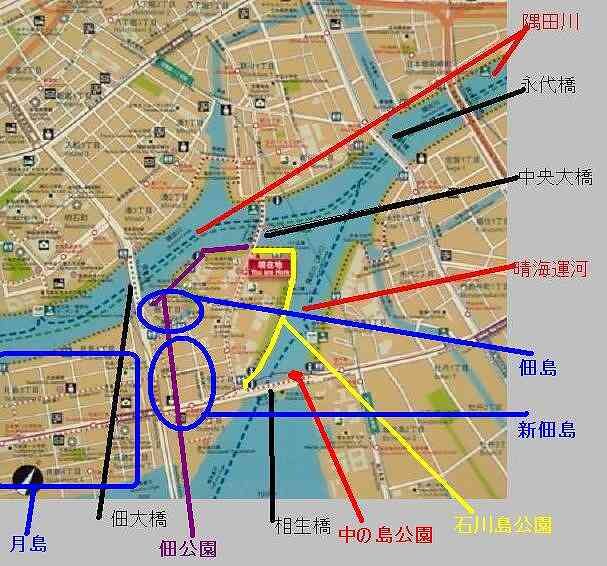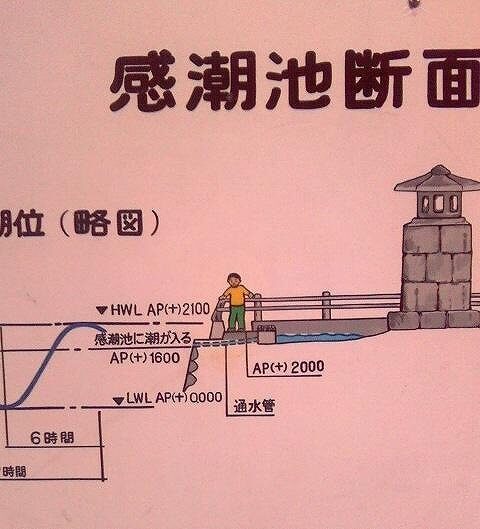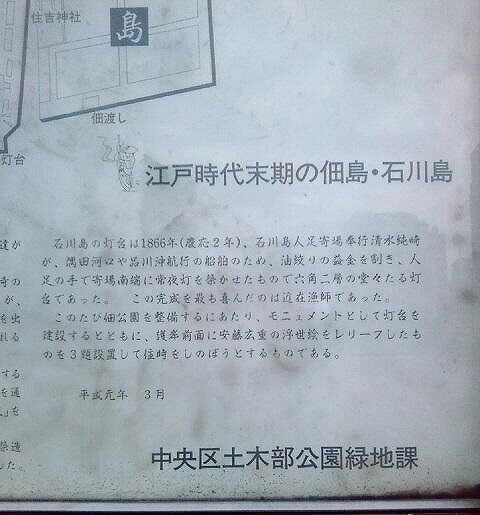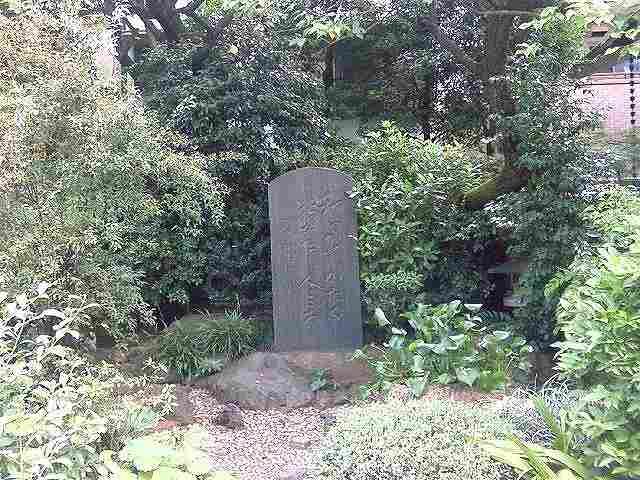Ishikawajima Park is located in Tsukuda, Chuo-ku, Tokyo, and is a municipal park along the Sumida River and Harumi Canal.
Ishikawajima was the location of Ishikawajima Harima Heavy Industries, and as you can see, this is where the shipyard of Ishikawajima Harima Heavy Industries was located.
This Ishikawajima Park is located near the Okawabata River City 21 and is a quiet, relaxing, and calm spot for a hidden rest and relaxation in the heart of the city. It is also a cherry blossom viewing spot in spring.
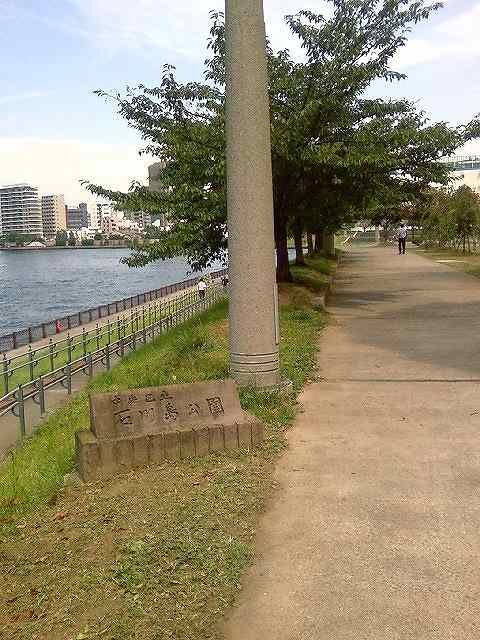
At the entrance of Ishikawajima Park, there is a stone monument with “Chuo Ward Ishikawajima Park” written on it.

This is a picture of Ishikawajima Park from Chuo Ohashi Bridge. The pillar in the center is the pillar in the photo above.
The left is Sumida River, upstream in the front and downstream in the back.
The lower left and right sides of the photo are the parapets of the Chuo Ohashi Bridge.
Ishikawajima Park is an L-shaped park that turns right at the back of the photo to the vicinity of Aioi Bridge.
There is Paris Square, Time Capsule, and a private Western-style Shipyard at the end of the park.

If you continue through Ishikawajima Park or go back along Sumida River, you will see Eitaibashi Bridge.
Eitaibashi Bridge is also beautifully illuminated at night.

The left is Sumida River and the right is Harumi Canal. The bridge in the foreground is also the Eitai Bridge.
This position is the top of the Sumida River upstream side of Tsukuda Island.

When you come to the Harumi Canal side, there are hooks and floats for mooring boats.
This area is truly a waterfront, with parts of it flooded during high tide and after heavy rain.
Place de Paris
The Place de Paris is located in the right-angled bend of Ishikawajima Park, an L-shaped park, and is a 30-meter-diameter circle paved with granite and surrounded by benches. The reason why the Place de Paris is located in this park is, as anyone with a good sense can easily understand, due to the friendship between the Tokyo Metropolitan Government and the City of Paris.
The nearby Chuo Bridge was designed by a French design company, and in the center of the bridge there is a messenger that was exhibited at the Paris Expo, so the relationship with Paris is very close.

This square was named “Place de Paris” because of the friendship between the Tokyo Metropolitan Government and the City of Paris, and there is a “Place de Tokyo” in the 16th arrondissement of Paris.
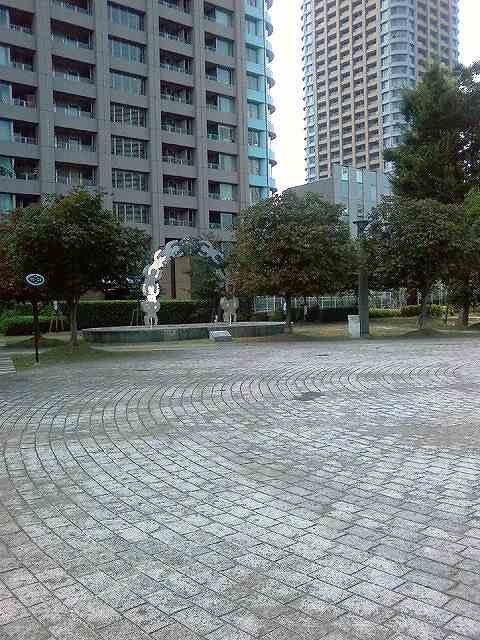
Granite of the Place de Paris. It is circular with a diameter of 30 meters.
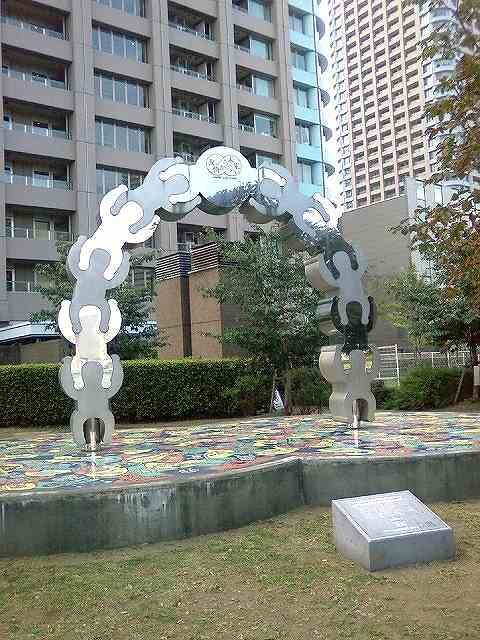
This silver arched monument is based on the image of children holding hands. Named “From Friendship to the Future”, it is likely to commemorate the founding of Place de Paris as well.
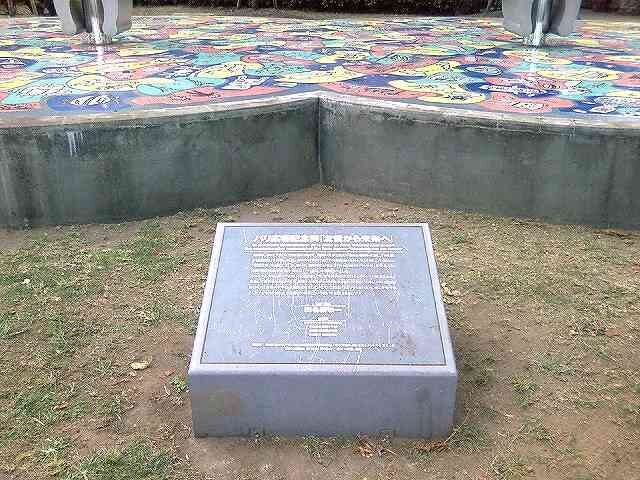
The colorful tile pictures drawn by the children are inlaid.
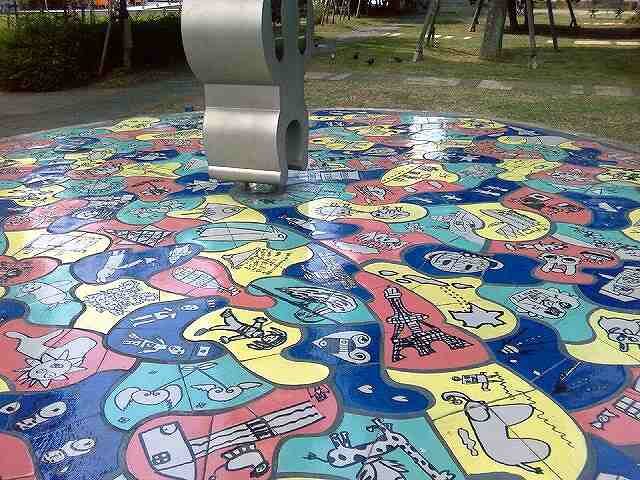
This tile painting was created by the children of Joto Elementary School and Tsukudoshima Elementary School in cooperation with Meisho Elementary School, which at the time housed the French school Lycée Franco-Japonais de Tokyo.
Time Capsule

There is a Memorial Time Capsule near Place de Paris.
This capsule was set up in 2004 as a commemorative event for the 400th anniversary of the founding of Edo, Chuo City. The capsule contains a commemorative DVD of images and videos to be handed down to the future, as well as a DVD of the 400th anniversary of the founding of Chuo City.
Speaking of time capsules, I am reminded of the 1970 Osaka World’s Fair. The Osaka Expo Time Capsule was jointly sponsored by the Mainichi Newspapers and Matsushita Electric Industrial Co.
There are two time capsules, the first for preservation, which will be opened in 6970 A.D., and the second, which will be opened and reburied for the first time in 2000 A.D., and the same process will be repeated every 100 years until 6970 A.D. after that.
I think the purpose of Unit 2 is to collect maintenance data for the main Unit 1, but it may also be meant to satisfy a feeling of not being able to wait.
I would like to open this time capsule of Place de Paris as soon as possible, but please wait a while. It will be opened in 2024, 20 years from now.
Birthplace of Japan’s first privately owned Western-style shipyard
The origin of IHI Corporation (formerly Ishikawajima-Harima Heavy Industries Co., Ltd.), a general heavy machinery manufacturer, is located in this Ishikawajima Park.
In 1853, the Ishikawajima Shipyard was established on Ishikawajima by Nariaki Tokugawa, the feudal lord of the Mito domain, and it became Ishikawajima Heavy Industries Co.
Later, Ishikawajima Heavy Industries K.K. merged with Harima Shipyard K.K. to form Ishikawajima-Harima Heavy Industries, Ltd. and changed its name to IHI.

This is an information plate of the birthplace of Japan’s first privately owned Western-style shipyard. You can learn about the origin of Ishikawajima Shipyard by reading this explanation.

Chiyodagata was a warship of the Edo Shogunate, the first domestic steam gunship, and was named Chiyoda “kata” because it was planned to be mass-produced for the defense of Edo Bay and Osaka Bay.
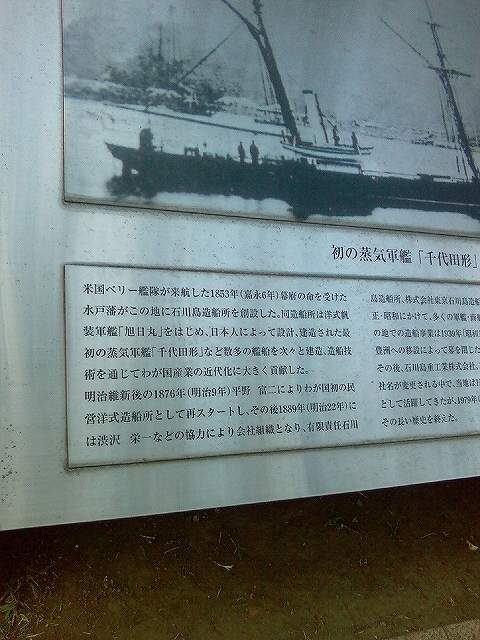
The Ishikawajima Shipyard was founded by the Mito Clan in 1853, the year of the arrival of Perry’s fleet in the United States, under the orders of the Shogunate.
The shipyard built many ships one after another, including the Western-style sailing warship Asahinichi Maru and the first steam warship designed and built by Japanese, Chiyoda-kata, contributing greatly to the modernization of Japanese industry through shipbuilding technology.
In 1876, after the Meiji Restoration, Hirano Tomiji re-started the company as Japan’s first privately owned Western-style shipyard, and in 1889, with the cooperation of Shibusawa Eiichi and others, it was reorganized as a company.
The company was reorganized as a corporation with the cooperation of Shibusawa Eiichi and others, and under the company names of Limited Liability Ishikawajima Dockyard and Tokyo Ishikawajima Dockyard Co.

The shipbuilding business in the area ended in 1939 with the relocation of the shipbuilding division to Toyosu, Fukagawa-ku, Tokyo.
The company was renamed Ishikawajima Heavy Industries, Ltd. and then Ishikawajima Harima Heavy Industries, Ltd. and the site remained one of Japan’s leading plants specializing in heavy machinery until 1979, when the plant was relocated to a new location.

